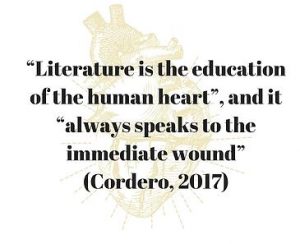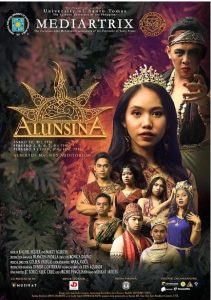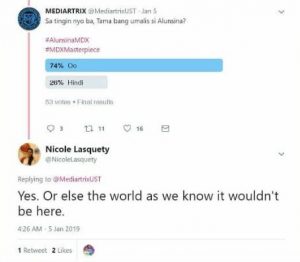One may recall reading or having to perform a skit of the Panay-Visayan creation myth “Tungkung Langit and Alunsina” also known as “Alamat ng Ulan” as part of one’s required reading in high school or college. According to this myth, whenever it thunders or rains, it is Tungkung Langit, Pillar of the Sky, calling his beloved Alunsina back home after she ran away because of his wrath at her disobedience. Alunsina however is still yet to be found to this day. The creation of the world as we know it, it is said, was an attempt to make the world a better place for the lost.

The textbook analysis of this Panay-Visayan creation myth is that it reflects the Filipino woman. Structuralism is a theory by Claude Levi Strauss which states that the structure of myths are composed of “binary opposites” (Douglas, 1967). That is to say, something can be understood because there is an opposite to compare it to. For instance, there would be no such thing as “bad” if everything were “good”. According to this view, Tungkung Langit and Alunsina reflect traditional conservative gender roles: active male; passive female (Lee, 2018). While this way of understanding things is useful and necessary, like any theory, it is not complete, and may run the risk of being reductionist. In real life, people are far more complicated than fictional characters.
As such, many adaptations have provided a different angle each with its own theoretical framework of the story.
Self-discovery as a Means to Empowerment in “Alunsina” by Mediartrix, UST

One of the adaptations that sought to break away from the Structuralist trope is “Alunsina” by Mediartrix, a multimedia organization at the University of Santo Tomas. With the focus on self-discovery and self-empowerment, Alunsina goes through a journey where she discovers her inherent power. In this version, Alunsina represents everyman/woman (the archetype of the ordinary person one gets to see every day) in order to show that anyone can be empowered and discover their unique role as well.

Gods with Human Sentiments
Throughout mythology around the world, higher beings are often shown to possess human weaknesses in terms of their character despite having supernatural powers. They are able to control the forces of nature at will, yet they lose control rather than showcasing superior foresight. These supposedly idealized characters that have served as a foundation of human belief systems also reflect human weaknesses, and this allows us to see ourselves in these characters. Recognizing these weaknesses may also help us understand the purpose of these characters in the story as the relationship dynamics of certain partnerships may add depth to each other.
The story of Tungkung Langit and Alunsina does not tell us everything such as whether Tungkung Langit’s accusation of Alunsina’s jealousy was true, or what really happened to Alunsina, and whether it was right for her to disappear. Rather, the story allows the audience to reflect on the possibilities themselves. But it isn’t only in the climax where we are given hints to what we can learn from the characters’ demise. Their profiles at the beginning may already give us clues.
The Unmarried One
Alunsina’s moniker certainly gives one a sense of an origin story. This name was attributed to her from the beginning of the story before the conflict began to unfold. It tells us that even before she took part in Tungkung Langit’s story, she was already living on her own. Yet how does this title remain relevant after she is married?
What this name might say about Alunsina is that she is her own person. She is not one in mind with Tungkung Langit, and so she decided to send the breeze to spy on Tungkung Langit. She couldn’t have come to him on her own for fear that she would get caught. This reveals that she does not know Tungkung Langit well enough to trust him. Therefore Tungkung Langit’s accusation of Alunsina’s jealousy may have been an attempt to mask feeling offended by her lack of faith in him.
However, by the same token, the pain of this accusation may be the reason Alunsina never returned. “Alunsina Takes a Walk in the Rain” by Conchita Cruz explores this. Alunsina is the persona in the poem, and it is full of contradictions. She begins by saying “It is difficult to miss you… I stay away from the windows”, and later on proceeds with “I will soak myself in your tears. It is difficult not to miss you”, and finally concludes with “I cannot forgive you”. Though she expresses that she had genuine love for him, she has yet to come to the end of herself, because she holds on to her pride to protect herself from getting hurt.

Others may read the conflict between Tungkung Langit and Alunsina as unbecoming of a benevolent god. However, part of wanting the best for Alunsina would require intolerance to unacceptable behavior, even if it hurt her.
“The hero saves the world, but who saves the hero?”
– Anonymous
Tungkung Langit however, is not without his share of blame. Though the story explicitly states that Alunsina is selfish, Rev. Eric Agustin, a Bible teacher at International Global School of Leadership points out that Tungkung Langit’s motive in creating the world was to call Alunsina back and was also self-serving, for he was only doing it to ease his loneliness. In this sense, Tungkung Langit is not a perfect being because the term “perfect” implies that he is complete, not in need of anyone else to love him back. He seeks Alunsina to complete him, rather than to complete her.
“Keeper of my Sky” by Timothy James Dimacali, explores the idea of what it’s like to be a lonely god. It is here that creation is described as a “painful birth”, taking the idea directly from the labor pains of child bearing. In this interpretation, Tungkung Langit’s characterization is more man than he is god, in that he is able to rule the world, and still not be complete.
The Absence of Gods in “The Alunsina Network”
This interpretation of love as a means to complete oneself is further illustrated in meLê Yamomo’s contemporary realist take of the Panay creation myth as world picture in a play entitled “The Alunsina Network”.
This Western adaptation incorporates Martin Heidegger’s concept called the “world picture”, “a metaphysical ground of an age” (Heidegger, 1938), a spirit that appears in all ideologies regardless of their differences (Young, Haynes, 2002)- the world conceived and grasped as picture, rather than a picture of the world (Hong, 2003). Because this structured image is so universal, the whole world is reduced to a system, and that system is the whole world.
The play is set in today’s world, a time in which, quite fittingly, Heidegger talks about the modern phenomena of the loss of gods (such as in Paganism) resulting in “a void that is filled by the historical and psychological investigation of myth” (Heidegger, 1938). For so long, humans have grown accustomed to having gods. The loss of gods disorients them, leaves them lost, and turns their interest towards myths. Though they no longer read into these myths in the literal sense, in an odd way, myths have more power as world pictures, since they encompass ideological differences.
All that is required for the world to become a picture is when man bases his life as reference for that picture to be formed. Man no longer needs to be connected with a higher being as well as others to gain a world picture from them. Man assigns meaning to things, the result of which has become a cultural shift from community and religion to individualism.

Individualism has become the norm of the modern age that it may sometimes be hard for younger generations to imagine that individualism how previous ages did not see this as a badge of honor or right of passage. Individualism was not easily understood, and therefore lead to isolation which was not what people needed in the survival of the fittest, because according to Ursula K. Le Guin’s book, “The Dispossessed”, the fittest were the most social (Le Guin, 1974).
Man “can now remain within his sphere as his sphere has effectively appropriated the aesthetics of the interpretation of man, i.e. culture” (Young, Haynes, 2002). Culture, in this case, myth, has become a simulation of everything man needs to form a world picture. The “spirit” or world picture that governs The Alunsina Network comes from the idea from “Tungkung Langit and Alunsina” that the world was created in search for love.
In the play, “The Alunsina Network” is the name of an online dating platform, which also serves as a quintessential metaphor of the attitude of the modern age: self-reliant, anxious to present an image of themselves to the world as a part of survival, dependent on state of the art technology for connection, distances made even shorter through globalization, and yet isolated now more than ever. The people who participate in the Alunsina Network do not leave their need to leave their “sphere” to pursue love. They no longer need to interact with people in person or learn what love is based on experience.
The Alunsina Network was created for people who are searching for love. Yet even then, because it is set in the age of the world picture, participating in the Alunsina Network is more than a pursuit of love. “Man fights for the position, which secures, organizes, and articulates itself as a world view, the decisive unfolding of the modern relationship to beings becomes a confrontation of world views” (Heidegger, 1938). He describes this as a “conquest of the world” (1938).
The world was created in search for love. Therefore, in order to continue existing, one must find true love (Yamomo, 2008). It is as if by participating in The Alunsina Network, one validates his very existence as well as everything he believes in. The Alunsina Network turns the pursuit of love into a game – “a conquest of the world through pictures of prospective partners” (Yamomo, 2008). The participants need love in order to survive. The paradox in the play is if man finds perfect love, then it will be the end of the world” (2008).
In spite of this, one may infer that perhaps, depending on one’s interpretation, the end of the world in this play is not the literal end of the world, but an escape from the world picture, where one is under the illusion that he is connected. Perhaps the end of the world is the beginning of a new life.
Alunsina Desap (Post-postmodernism, Existentialism)
“Hindi sa pagtakas o paglipad masasagot ng hangin ang hinahanap. Hindi sa pagpapanggap o pagpapakatatag mabibilang ang kayang iluha at itumba ng tadhana. Marahil tayo nga ay nawawala pa at marami pang hinahap.”
– Alunsina, Alunsina Desap (Ramirez, 2011)

“Alunsina Desap” showcases the richness of Philippine mythology through the character of Caloy, a Literature major who acts as a commentator of the play itself as the events unfold. He gets to meet Alunsina and immediately recognizes her as a character from mythology. Set in the hyper-real, Alunsina comes in contact with the people “our world”, who just like Alunsina, are either missing, losing direction, or in search for something or someone.
The play then becomes self-reflexive as Caloy makes a commentary on other works of literature sharing the experience of loss and being lost, hence the name “Desap”, which refers to desaparecidos or a disappeared person.
Toward the end of the play, he comes to the conclusion that all the he, along with the rest of the characters, are all products of the world that was created in the myth, while the gods themselves are in turn products of the imagination of the people who invented their story. This creates a riddle of causality, parallel to the chicken and egg question – “Which came first?”
These postmodern literary devices however were not merely stylistic additions. Each serve a role in the story. This revelation lead Alunsina to discover that though she is just a made up character, she has the power to choose her next move. Having developed compassion for the other characters, Alunsina chose the creation of the universe as we know it over being reunited with Tungkung Langit, even if it means she would be wandering forever, in the hopes that the lost would find what they are looking for by the time she finally returns to Tungkung Langit once and for all. By doing so, she reminds the characters that they too have the power to choose their destiny, because Alunsina’s story is also their making.
“… Pero ako’y nagkapagpasiya nang makipaghiwalay kay Tungkung Langit pagkat pipiliin ko pa ring malikha ang mundo ninyo. Kayo ang dapat na mapagpasiya at kayo ang tunay na gagawa ng inyong kapalaran. Hindi kaming mga diyos o Bathala. Andito kami para kayo’y gabayan at tandaan nyo, ang aming mga tadhana ay inyo ring gawa.”
– Alunsina, “Alunsina Desap” (Ramirez, 2011)
It must be noted however that though the play makes use of postmodern literary devices, the play itself may be more fitting as post-postmodern literature. While postmodernism leaves the audience with a lot of morally ambiguous questions, modernism actually gives the audience answers. Though some do not believe in post-postmodernism, arguing that it is just a return to modernism, post-postmodernism combines postmodern stylistic devices, but whereas the irony and cynicism that characterizes postmodernism tends to render the work as rather nihilistic, post-postmodernism transcends this with modernist sincerity and faith (Barker, n.d.). “Alunsina Desap” ends on a positive note based on compassion and hope for the lost.
The play has served as the main inspiration for my two adaptations. The first is a pop-up book, which plays with the concept of free will. Here chaos is depicted by personifying what little might have existed of the primordial world. Time, Space, and Light take on the form of animate entities with minds of their own. Rather than asserting her own independence by leaving, Alunsina is portrayed as an equally active character.
In this version, Alunsina foreshadows that the primordial chaos is not the only thing they must face, but they must be strong for one another in order not to let the chaos come between them. Instead of sending the breeze to spy on Tungkung Langit, she goes after him herself and together they bring back order in the cosmos, and create the universe side by side as a monument of their love.
Theodicy
As the driving force for the creation of the universe in the story was love, the world that resulted was full of beauty, but also suffering. I was then faced with the challenge to incorporate these two contrasting elements in the artwork, as well as turn a rather serious story with a sad ending into something that would appeal to children ages seven to nine and leave a positive and memorable message. One of the first things children asked as I presented this to them was why the man was crying, but they were also attracted by the color and interactive elements.
In part one, Unity, the gods are fixated upon one another, as if their world depended on each other being by their side. In part two, Separation, the characters were placed on opposite ends, Tungkung Langit creating thunder and rain as he would cry out with all his might, and Alunsina against a colorful background as though lost in space. Their separation marked the beginning of suffering, but it is balanced out by the sun, which represents hope. Finally, in part three, Creation, birds fly out of Tungkung Langit’s chest towards Alunsina’s direction depicting his heart going out to her. The viewers then manipulate the blooming flowers, the final element representing beauty, as if to help Tungkung Langit woo Alunsina back to him, but also to show that despite suffering, love makes the world a beautiful place.
To bring cosmic order where there was chaos is a great feat that often requires some supernatural or divine power that only comes to a person once in a generation, or even for eternity. Yet it is rendered an easy task in comparison to the challenges in the realm of the ordinary, where for the rest of the mere mortals is the only place they get to act – the place from which people learn about the stories of the supernatural. The hero still has to face the troubles that every man has to face such as social pressures. This vulnerability is what humanizes an otherwise invincible force.
This separation or loss may not necessarily be the result of the hero doing something unforgivable. Neither is it because the woman in the story is her own person; a strong independent woman – though she most certainly is. Rather, the hero fails to save or keep the one person that matters to him most because of the inevitable suffering in an imperfect world.
Yet despite this phenomenon of life, stories like this offer hope. Despite all odds, the world is restored to order. Despite the loss or separation from a loved one, the conviction to make the world a better place, does not die or disappear along with the loved one.
SOURCES:
Books
Jocano, F. (1969). Outline of Filipino Mythology. Manila: Manila Centro Escolar University Research and Development Center.
Jocano, F. Landa’s adaptation of Alunsina and Tungkung Langit in Lumbera, Bienvenido and Cynthia N. Lumbera (Eds.). Philippine Literature – A History and Anthology. Pasig City: Anvil Publishing, Inc., 2005.
Online Articles
Gonzales, V. (2011). Pagkawala/Kawalan bilang Metatext, at ang mga Pigura ng Pag-ibig sa Alunsina Desap – Vlad Gonzales. [online] Vladgonzales.net. Available at: http://vladgonzales.net/blog/2011/03/13/pagkawalakawalan-bilang-metatext-at-ang-mga-pigura-ng-pag-ibig-sa-alunsina-desap/ [Accessed 10 Apr. 2019].
iWonder. (2013). Structuralism on Philippine Creational Mythology. [online] Available at: https://jewelmercader.wordpress.com/2013/10/21/structuralism-on-philippine-creational-mythology/ [Accessed 13 May 2018].
Maiquez, R. (2011). Manuscript: Alunsina DESAP. [online] academia.edu. Available at: https://www.academia.edu/24894130/Manuscript_Alunsina_DESAP [Accessed 10 Apr. 2019].
Sherry, P. Theodicy | theology. Retrieved from https://www.britannica.com/topic/theodicy-theology
Seminar
Cordero, K. (2018). Huntahan Panitikan; A Forum on Contemporary Philippine Literature.
Video
Beretta, B. (2019). The Alunsina Network Performance. [image] Available at: https://www.youtube.com/watch?v=k0bsUzxGnCA [Accessed 13 Sep. 2019].
Theater Nieuwe Doelenstraat (2019). {The Alunsina Network}. Available at: https://www.youtube.com/watch?v=9U87N6wWetg&t=4s [Accessed 21 May 2019].
University of the Philippines Los Banos (2019). Alunsina Desap uplb. Available at: https://www.youtube.com/watch?v=aOavnd8ECuw [Accessed 20 May 2019].
Photos
Mediartrix (2019). Alunsina poster. [image] Available at: https://www.wheninmanila.com/mediartrix-features-filipino-mythology-presents-in-new-musical-production-alunsina/ [Accessed 8 Apr. 2019].
Yamomo, m. (2008). The Alunsina Network. [image] Available at: http://site.meleyamomo.com/portfolio/the-alunsina-network/ [Accessed 8 Apr. 2019].
ALSO READ: Tungkung Langit & Alunsina | The ‘Other’ Visayan Creation Story
A graduate of Fine Arts major in Painting at the University of Santo Tomas, Nicole Lasquety is a visual artist and writer with a passion for media exploration where big ideas are commonplace. Her broad range of artworks include surreal, kinetic, wearable, and abstract art.


